[one_half padding=”0 0 0 0px”]
Weatherby
[/one_half]
[one_half_last padding=”0 0 0 0px”]
[/one_half_last]
Before he created the Weatherby Mark V action, Roy Weatherby was a hand loader. In fact, the Mark V action was the result of his quest for a rifle strong enough to test his hottest loads. (You know how those hand loaders are-always pushing the envelope.) To this day, many still consider the Mark V action to be the strongest you can buy. In a world of superlative claims, there’s a lot to back this one up. The Mark V Terramark RC is a solid performer.
The receiver and recoil lug are machined from a single blank of forged steel. Forged steel has several benefits over cast steel. Forged parts withstand impact better, are fine grained without porosity or cavities, and have better wear resistance. The recoil lug is also machined from the same block of steel as the receiver, making it inherently stronger.
The bolt obviously has a big job to do. In case you’re not familiar with the .300 Weatherby Magnum cartridge, it’s the H&H Mag’s bigger brother. It even has a few hundred feet per second muzzle velocity over the .300 Win Mag. With peak chamber pressure in the neighborhood of 65,000 psi, a bolt failure is totally unacceptable. Machined as a single piece, the Weatherby Mark V bolt is considerably stronger than bolts made in separate pieces and welded together. The bolt body is the same diameter as the locking lugs for strength, less wobble, and ease of operation. The bolt face is recessed to enclose the cartridge case head. When the action is closed, the bolt face is enclosed within the barrel chamber wall which is, in turn, enclosed within the receiver. This protects the shooter against the effects of a possible case head failure and is referred to by Weatherby as the three rings of steel. To assure a solid lock-up the bolt has nine locking lugs. Count ‘em, three rows of three.
There are several other bolt features that, while not a contributor to strength, are a plus for the shooter. The bolt is fluted which reduces weight and bearing surface, making the bolt action smoother. In the event of a primer rupture, three ports direct high pressure gasses back and to the side. The rear of the bolt sleeve is also fully enclosed to direct gasses away from the shooter’s face. The thumb safety on the right side is quiet and easy to operate with your strong side thumb. The bolt throw is only 54 degrees, the shortest in the industry, which makes for faster operation and better clearance from scopes. This is a very quick and smooth action.
As rugged as the Weatherby action is, the durability of the design doesn’t stop with the steel parts. The raised comb Monte Carlo composite graphite and Kevlar stock uses 6061 aluminum bedding plates for stability and repeatability shot-to-shot. The stock has a gel coat in Desert Camo and most of the gun’s steel is protected with Flat Dark Earth Cerakote. This is a hunting rifle and it can easily stand up to the elements. The stock is capped with a Pachmyer Decelerator butt pad, and you need it. That 165Grain bullet comes out of the muzzle at better than 3,300 feet per second and with more than 4,000 foot pounds of energy. As Newton put it “for every action there is an equal and opposite reaction.” All that keeps the gun from flying into the next county is your shoulder. Fortunately, the Pachmayer Decelerator pad does a great job mitigating the impact. Kind of like getting kicked by a mule with pillows on its hooves. When you’re hunting you’ll likely be well padded with cold weather gear. I wore a T-shirt so I used a Caldwell Lead Sled to avoid hoof prints.
Most experienced riflemen will tell you the key components to accuracy are the trigger and the barrel. The trigger is pre-tuned at the factory to break around 3 ½ pounds. It can be adjusted by the user for let-off weight so I reduced it to the 2 ¾ pound minimum. I seem to shoot better with a lighter trigger. You might prefer the 3 ½ pounds or more — to each his own. Regardless of your preference, it was a sweet trigger with no creep or stacking and a crisp, clean break.
The barrel is button-rifled, free-floated, fluted stainless steel with a recessed target crown. The contour is tapered to provide nearly the rigidity of a bull barrel without the heft. The fluting further reduces weight. Hot or cold, the gun shoots where you aim it.
Specifications
- Weight: 8 ¾ pounds
- Barrel: 26” fluted stainless steel
- Rifling: 1-10”
- Overall length: 46 5/8”
- Trigger: Fully adjustable
- Magazine Capacity: 3+1
- Stock: Monte Carlo
- Length of pull: 13 5/8”
- Drop at comb: ¾”
- Drop at heel: 1 ¾”
Before we look at the range results, you need to know how this tack driver gets aimed.
Burris Eliminator III
If you were to buy a Weatherby Mark V, you’d typically want to mount a scope that matched its quality. Companies like Schmidt-Bender, Swarovski and Zeiss, for example, have spent a long time developing a quality image. Burris started out as a low to mid-priced manufacturer. However their product quality has continued to improve and they’re now making some top grade optics. They have also been known to innovate, like introducing the first handgun scope back in the mid sixties.
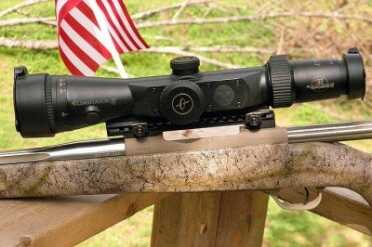
Burris Eliminator III, the latest and most competent iteration of their popular Ballistic Laserscope.
Today they manufacture the best scopes combining a laser rangefinder and ballistic computer. Actually, the only scope that does all that the Eliminator does at an affordable price. The Weatherby has the accuracy for long range shots and the Burris Eliminator III is capable of providing firing solutions for extending your reach. In addition, if the Eliminator can withstand the 300 Wby Mag recoil, it should easily stand up to whatever caliber you’re likely to shoot, which makes for a better test of real world performance.
The Eliminator III is the latest iteration of a scope which combines a laser range finder, ballistic calculator, and illuminated reticle. It not only calculates the effect of ballistics and atmospheric conditions on the flight of the round, but also shows you how to aim to get first-round hits on your target at any distance and wind (within the range of your particular round) out to a max distance of 1,200 yards with a reflective target. Fur is not a great reflector so you’ll only get ranging out to about 750 yards with a deer-like animal. I ranged a tree crown at 756 yards but couldn’t get a solution for the tree a few hundred feet behind it. A big tree trunk or rock would help you get distance data farther out.
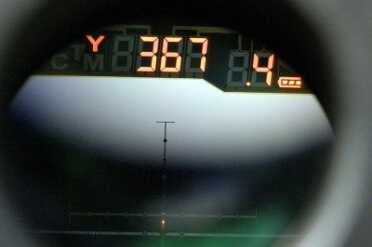
With the scope turned on (by pushing the on/range button on either side) simply push the range button to get a target solution. The “Y” on the left means the computer is set to yards instead of its alternate setting of meters. The middle number is the distance to the target, and the number to the right is the number of dots to hold into the wind per every 10 mph of crosswind. To the far right, the battery indicator is showing a full charge.
The scope comes with a quick start manual but I recommend going to the complete manual which comes with the scope. You can also see the manual on their website to download the complete User’s Guide. One way or the other, you must read the User’s Guide (unless you have someone else set it up for you). The first time through will have your head spinning like Linda Blair in the Exorcist. As you read it again it becomes clear that it’s not as complicated as they try to make it. I know, they’re trying to give you the reasons behind what you need to do so you understand why you’re doing it. Don’t let it throw you. There are really only three things you need to do:
1.) Find the ballistic coefficient (B.C.) for the bullet you’ll be using and the bullet drop at 750 yards,
2.) program these numbers into the scope, and
3.) zero the scope on your rifle at 100 yards.
This may sound challenging, but Burris makes it relatively painless by including a cartridge list giving you the B.C. and bullet drop for more than 1,400 factory cartridges. They also list that information on their website. Sometimes this data may come with your gun or can be found on the ammunition manufacturer’s website or in reloading manuals. Sometimes not. Weatherby includes a data sheet with the Mark V which lists information like bullet weight, bullet style, B.C., muzzle velocities, and bullet drop out to 500 yards. This data is for the Weatherby brand ammo which is what they use as a reference to guarantee the accuracy of less than 1 minute of angle (moa) which is less than 1” at 100 yards, 2” at 200 yards, etc. However, they use a 200 yard zero instead of the 100 yard zero required by the Eliminator, so the drop data isn’t a big help. Three cheers for Burris for having the needed information in a well-organized list.In the unlikely event that your cartridge isn’t on the Burris list or if you’re making up your best handload, there are lots of free ballistic calculators available online like the ones at Hornady and Shooter’s Calculator.
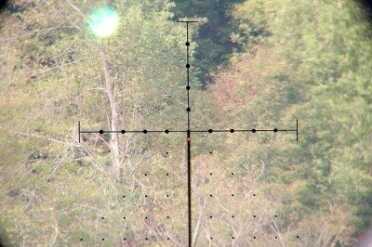
The unit indicator (Y or M) and distance turn off after 10 seconds but the wind offset and the aiming dot (just below the crosshairs) remain illuminated for another 80 seconds then turn off. That’s considered one cycle. The battery is good for about 5,000 cycles.
The ballistics calculators need the drag function (generally G1 unless otherwise stated), bullet weight, muzzle velocity, B.C., zero range, and sight height above the barrel axis, minimum. If you want, you can also input environmental data like altitude, humidity, and temperature. If you zero at sea level than go on a hunt at 9,000 feet, the change in altitude will have an effect on the flight path of the bullet, so you need the B.C. and drop data for the altitude where you’ll be hunting.
If this seems confusing, welcome to the world of long range shooting. At distances up to about 350 yards, depending on the cartridge and rifle, you’re close to the point blank range which means the trajectory of the bullet is relatively flat. Beyond that, the bullet arc increases dramatically and the variations imposed by distance and wind get progressively larger. The aerodynamic slipperiness of the bullet shape (B.C.), its weight, and its velocity all contribute to how quickly it’s going to drop. Military snipers go to school to learn everything they need to know to shoot accurately at extreme distances. The Burris Eliminator III puts the ability within reach for the average shooter. The price is that it must be properly calibrated. Once that’s done, using the scope is relatively easy. It does work.
I found the simplest method was to use the data from the Burris cartridge list and adjust it for altitude with the equations provided in the User’s Guide. I shot the targets featured in this article at an altitude of about 1,100 feet. (Actually I was shooting from just over a thousand feet to just under twelve hundred since the range was on a hillside.) The Burris cartridge list also includes the data you’ll need for this. Someone did a lot of work to prepare that list! They give an example which makes it an easy task taking just a few minutes. All this sounds more difficult than it really is.
Programming is straightforward. If you’ve ever set a multifunction watch, you’ll find it quite similar. Write out the buttons that you push and when if you need to, but you’ll soon be doing it without the crib sheet.
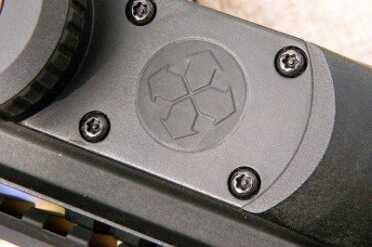
The sealed buttons behind the battery cap (arrows) are used to program the ballistic computer and to set illumination intensity.
Zeroing is just like any other scope. Just remember that the clicks of adjustment are 1/8 moa or 1/8” at 100 yards. I spoke with Eric Joyce, owner of the Shootin’ Shed Gunshop and Range in West Winfield, NY (315-822-3012). He’s calibrated Eliminator scopes for a half dozen of his customers and is able to do a proper zero in 10 rounds or less. He uses a zeroing target from Redfield with diamonds for aiming points and a 1” grid for the background (see the target I shot at the 605 yard distance.) His method is to start at 25 yards (which is also what Burris recommends), fire three rounds, adjust the scope, and fire two or three to confirm. Then he goes to 100 yards and repeats the process.
It took me 13 rounds. The first group was low 2 ¼” and left of center 8”. (I used a tape measure to be more precise with my adjustments. Weatherby brand .300 Wby Mag rounds are about $3 each so I didn’t want to waste them.) That’s 18 clicks up and 32 clicks right. The adjustment brought the next group to 3/8” from dead center. 3 more clicks and I fired for confirmation. The next 3 rounds were to the left of the center. I then cleaned to barrel and fired 2 more shots which landed just to the right of the center. (Eric, an experienced distance shooter, advised me never to clean the barrel in the middle of the group because it will change the point of impact, as I had just learned for myself. In fact, before he goes to a distance shooting match, he cleans the barrel then fires a couple of rounds to foul it since the gun was zeroed with a fouled barrel.)
That result was good enough to shoot the rest of the evaluation, although I would have shot another group to confirm my zero was dead nuts centered if I was preparing for a hunt. Next I went to 300 yards, 500 yards, and the most distant target on the range at 600 yards.
When you range a target with the Eliminator, you have to use the center of the etched reticle. Turn on the scope with the press of the on/range button, press it again to range, and you’ll see the units you’ve selected (Y for yards or M for meters) displayed in the upper left of the scope. Right of that is the distance in yards (or meters) followed by the wind offset number. This number tells you how many dots to hold left or right for every 10 mph of crosswind. If you have a 15 mph crosswind, hold 1.5 times that number, for a 5 mph wind hold half that number, etc. It’s easy to apply. The tough part is figuring out what the crosswind really is. The distance number is the actual line-of-sight distance. I was shooting at up to 5 ½ degrees of elevation. The scope has an inclinometer built in and calculates the horizontal distance to the target since this is what determines the actual bullet drop.
Up to this point I’d never taken game or shot at a target beyond 300 yards. If this is new to you, we’re learning together. Any of you extreme distance shooters out there who’d care to share your advice, your comments would be greatly appreciated.
The Mark V Terramark RC is guaranteed to shoot sub-moa groups. It even says so on the hinged bottom plate. At 100 yards, it shot into 5/8 moa. The Mark V and the Eliminator definitely make an accurate combination.
At 308 yards, I checked the first shot since when you’re actually hunting, that’s the one that counts. Less than ¼” above the center of the bull. The next two shots were within ¾”. Great, but I’d shot at 300 yards before. That’s still close to point blank range. Lining up the shot at 511 yards and 5 degrees of elevation, I really didn’t want to miss the target, but instead of adding a wind correction as I should have, I put the aiming dot on the center of the target. Nearly 9 1/2” low and to the right. (Thinking about it later, I guess I just didn’t trust what the scope was telling me.)
The Eliminator calculates the offset for wind but you still have to estimate what the wind actually is. Since I had driven up to the top of the hill where the 500 and 600 yard targets were, I knew that the wind was varying from 0-15 mph. In addition, the treeline blocked some of the wind for the targets to the right. Estimating wind is a real challenge. I can see why most long distance shooters, including military snipers, use spotters to advise them of where the round actually impacts. I put in a 5 mph wind correction and fired 4 more rounds. That 4-round group was 5 7/8” across or 1.17 moa. The farthest round from the point of aim was just under 5” to the right. I should have put in a 7 mph wind correction.
The next target was at 605 yards. (I was already beginning to love knowing the range as soon as I got on target.) Since this target was protected from the wind, I put in an offset for a 10 mph for a crosswind from the left. I missed the left edge of the 15” by 17” target completely. Too much correction. Using a 5 mph offset for the next group, it centered 5” low and 4 ½” to the right. (I should have used a 7 mph offset, again.) Excluding the one flier, the group was 5 ¼” or 0.87 moa. The fact that the rounds were impacting progressively lower at the longer ranges told me that the B.C. or bullet drop numbers needed to be fine tuned. The User’s Guide tells you how to do this. If I was preparing for a hunt, I’d do it to make sure the gun was shooting the center of the target at the longer ranges. Ammo cost and availability prevented me from proceeding to a proper long distance sight-in. However, I had the information needed to know that the scope is a solid performer and makes distance shooting a whole lot easier.
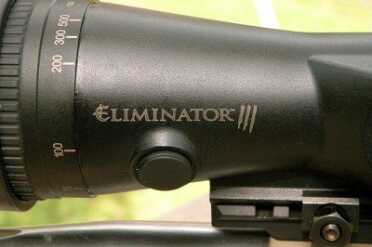
A button on either side of the forward bell is used to turn the scope on and for ranging. It’s used in conjunction with the programming buttons to enter the programming mode.
Specifications
- Magnification: 3-12 power
- Objective: 44mm
- Laser range reflective target 1,200 yards
- Laser range deer: 750 yards
- Laser accuracy: 99.5%
- Battery: CR123A (included)
- Battery life: 5,000 cycles
- Field of view at 100 yards: 33-9 yards
- Weight with mount & battery: 28.8 oz.
- Eye relief: 3.5-4”
- Overall length: 13.5”
- Mounting rail length: 6.9”
The objective of this evaluation was to judge the quality, ergonomics, and accuracy of both the Weatherby Terramark AC and the Burris Eliminator III. While not a featherweight, the Weatherby is still light for what it does – shoot a .300 Wby Mag round into less than 1 moa at long distances. It is rugged and user friendly as well. To unload the magazine, for example, you simply release the hinged floor plate with a button in the front of the trigger guard. It’s convenient, safe, and requires enough pressure to activate the button that a heavily gloved finger shouldn’t do it inadvertently. Quality of the fit and finish was everything you’d expect from Weatherby. No tool marks anywhere, a tapered mouth to the chamber to facilitate smooth feeding, clean engraving, exacting tolerances. It’s a rifle any hunter would be proud to own. And the accuracy, of course, was phenomenal. If I can shoot groups this tight, a really good shooter could certainly do better.
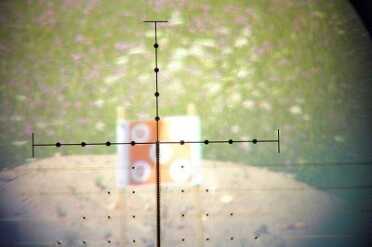
It was difficult to capture decent photos through the scope. The view was actually much brighter and clearer than it appears here. This shot was included primarily to show you what the un-lit reticle looks like.
As for the Burris Eliminator, if you trust it, it will work as advertised. Shooting with it is the best way to build that trust, especially if you’re new to long distance shooting like I am. The aiming dot and wind correction display is correct at whatever magnification you’re using. The controls are easy to use and quick to adjust. The windage and elevation knobs are precise allowing for fast zeroing. And the exterior is non-reflective (except for the objective glass), and rugged. The programming may seem confusing at first and you have to read the manual (or get someone like Eric Joyce to set it up for you). But once you’ve done that, you’ll find it’s really straightforward and easy to do. The scope is a little bulkier and heavier than a simple variable power scope, but it’s a great feeling to put that illuminated range dot on target and get good hits out to 600 yards and beyond. There are always trade-offs and this one wouldn’t stop me from buying an Eliminator III. Now I want to take it to a 1,000 yard range!
MSRP for the Weatherby Terramark RC is $2,800. MSRP for the Burris Eliminator III is $1,904, but I’ve seen it offered in the $1,100-1,200 range.
***
Special Thanks to Shootin’ Shed Gunshop and Range: Eric Joyce, 315-822-3012, and Vernon National Shooting Preserve.
[one_half]
[/one_half][one_half_last]

The objective (front) lens has a parallax adjustment from 50 yards to infinity. Simply rotate to the appropriate range or until you have the sharpest focus.
[/one_half_last]
[one_half]
[/one_half][one_half_last]

Certified and guaranteed to shoot less then 1 moa accuracy. The smallest group at the range was 0.37. Promise delivered.
[/one_half_last]
[one_half]

At 605 yards and about 5.5 degrees inclination, the 5-shot group measured 9 ½”. Eliminating the flier to the left leaves a 5 5/16” 4-shot group, just under 1 moa. Needed a little more wind offset. A slight adjustment to the B.C. programmed into the Eliminator would center the group on the diamond.
[/one_half][one_half_last]
[/one_half_last]
[one_half]
[/one_half][one_half_last]

Holding a correction for a 5 mph crosswind, produced a 4-shot group just inside 6”. Should have used a 7 mph correction.
[/one_half_last]
[one_half]
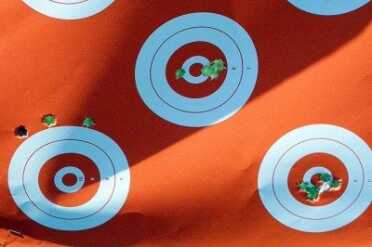
Zeroing target. With the center bull as point of aim, the first 3 rounds impacted just above the lower left target. After making a scope adjustment, the next 5 rounds grouped close to the center. A final adjustment produced the group at the lower right. If I was zeroing for a hunt, I would have fired another group to confirm the zero. Considering this was simply for evaluation, plus the rounds cost $3 each, I went with this zero.
[/one_half][one_half_last]
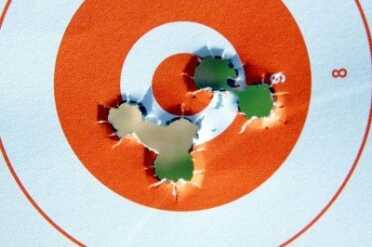
Zeroing shots 9, 10, and 11 on the left. I shot 12 and 13 after cleaning the barrel which caused them to move right and up.
[/one_half_last]
[one_half]
[/one_half][one_half_last]
[/one_half_last]
[one_half]
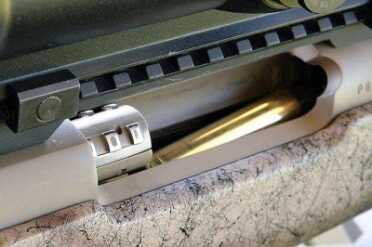
The Mark V is a push feed rifle. You can see the bolt picking up the top round from the magazine as it travels forward.
[/one_half][one_half_last]
[/one_half_last]
[one_half]
[/one_half][one_half_last]

To give you an idea of the size of the rounds, an empty .300 Wby Mag case is longer than a fully loaded .308 Win round.
[/one_half_last]
[one_half]

The Weatherby brand .300 Weatherby Magnum 165 grain spire points produced in the neighborhood of 3,300 feet per second velocity and 4,000 foot pounds of energy at the muzzle.
[/one_half][one_half_last]
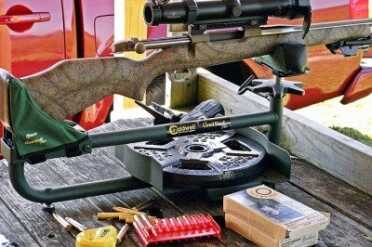
A Caldwell Lead Sled absorbed most of the recoil. Shooting in a T-shirt without the Lead Sled, it stops being fun pretty much after the first shot.
[/one_half_last]

The 600 yard rifle range at the Vernon National Shooting Preserve rises from 1,046 feet at the firing line to 1,200 feet at the top of the ridge.
[one_half]
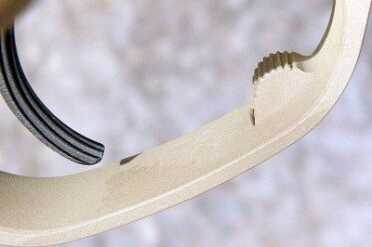
You can see the floor plate release button better here. It takes enough force to release that you don’t have to worry about a gloved finger accidentally dumping your rounds onto the ground.
[/one_half][one_half_last]
[/one_half_last]
[one_half]
[/one_half][one_half_last]
[/one_half_last]
[one_half]
[/one_half][one_half_last]
[/one_half_last]
[one_half]
[/one_half][one_half_last]
[/one_half_last]
[one_half]
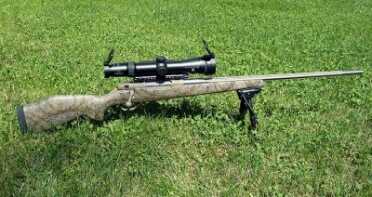
The stock and receiver/barrel assembly are securely mated with two hefty screws and aluminum alloy bedding plates.
[/one_half][one_half_last]
[/one_half_last]
[one_half]
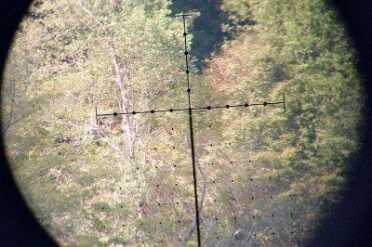
A little better shot through the lens showing where the distance data appears relative to your view through the scope. These shots definitely do not do the image quality justice.
[/one_half][one_half_last]
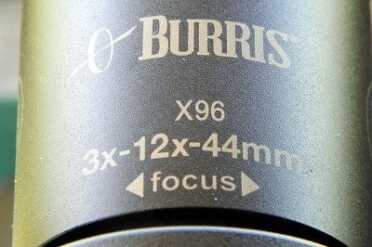
The 3-12 power zoom is appropriate for a wide range on hunting. The 44mm objective delivers plenty of light for most situations.
[/one_half_last]
[one_half]
[/one_half][one_half_last]
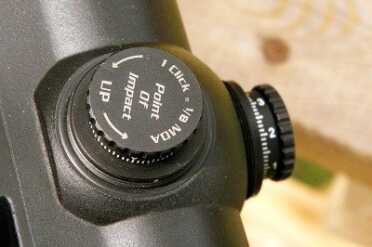
Windage and elevation are adjusted in 1/8 moa (1/8” at 100 yards) increments. I found the adjustments to be precise for efficient zeroing.
[/one_half_last]
[one_half]

The Eliminator is variable from 3 power to 12 power with a knurled ring. The Raised bar aids in making quick adjustment and to overcome the drag of the seals.
[/one_half][one_half_last]
[/one_half_last]

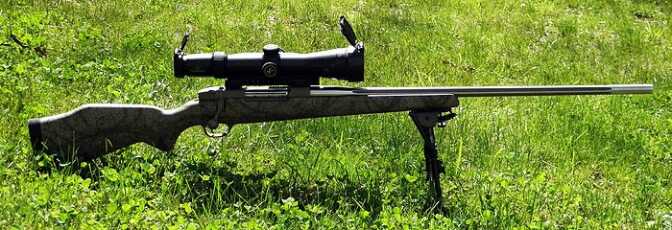
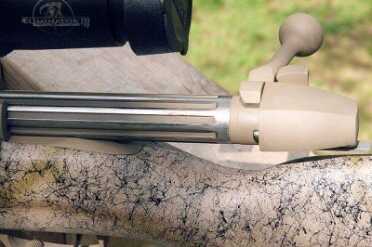
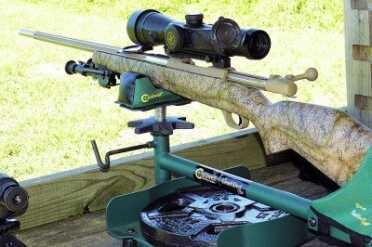
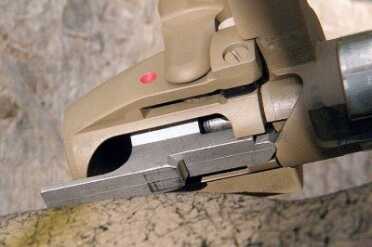
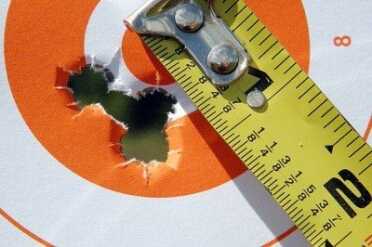

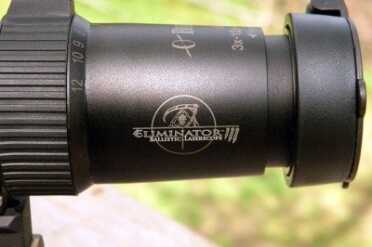

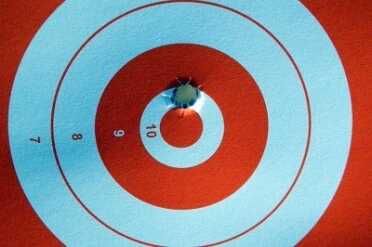


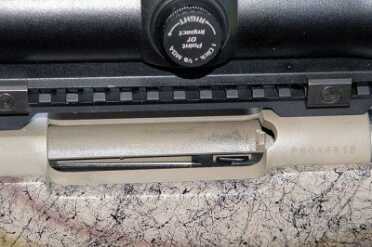
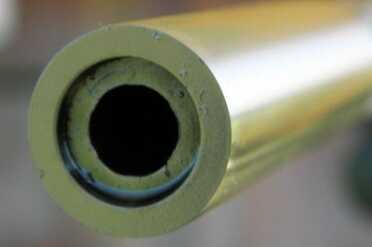

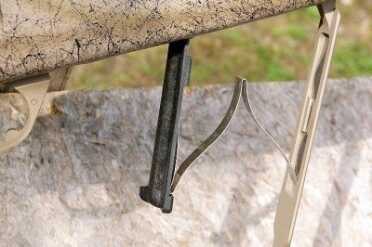

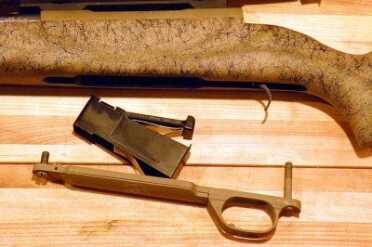
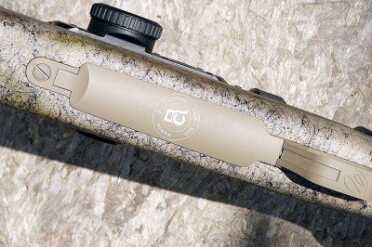
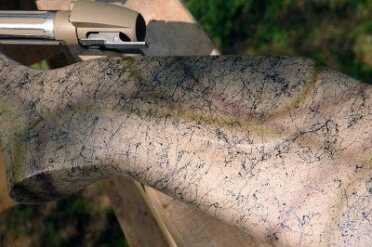



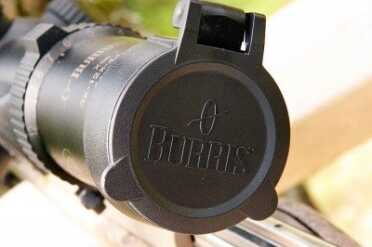
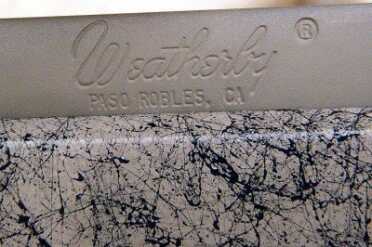
The Mark V Terramark RC sounds like a solid performer, and I’d love to learn more about its features.
Incredible work! Your attention to detail and thorough research is evident.
Great article – well written – tons of great details even for someone like myself with a weatherby 300 mag as a go to rifle … The combination with this scope seems awesome 😉 Joel
I have a Winchester Model 70 Pre ’64 that was originally chambered for 300 H&H that Roy Weatherby rechambered to his 300 Wby. It is one of my prized rifles in my collection. It’s point blank range is 450 yds with a 180 grain Nosler Partition bullet. It is my go to rifle for elk or moose. I probably could use it for brown bear but for those big bruins I prefer a little more. Hence the 375 H&H. Good article on the new Weatherby and the Burris Eliminator. I have been curious about that scope for a while now. It’s sound very complex but once properly dialed in, almost effortless to use.
Thanks again
Randall Lawless
I got my first Weatherby 20+ years ago, a ultra-light in 30-06, I love it and it’s all I carry. It’s been all over the USA and Canada and taken all types of game. With a leapold VIII 4.5-14 X 50, it’s been and still is a deadly combination.
Bought a Mark 5 Ultra Light 10 yrs ago ..Love it….Bad shoulders so I got 30/06 ..Took out the front bumps in stock and very consistent now..Can’t beat stock design..Muzzle break really settles light guns
Great article. I also have a Weatherby Mark 5, in .300 Wby. Mag., a nicely stocked Deluxe model, that has been free-floated and the action glass-bedded, with the relieved barrel channel sealed with a thin coat of the same epoxy used to bed the action. A Pachmeyer Decelerator pad finished off the slight ‘tweaks’ done, and with Weatherby ammo it will shoot 0.5 MOA all day! I wouldn’t trade it for anything! A nice Leupold 3×9 VXR Scope tops it, and my confidence in it is supreme! The new Terramark Series, with the Kevlar stock and Ceracoat finish, is a great hunting rifle for any conditions, and the Burris scope sounds really interesting. Great informational piece on how they work together!!
The “tail” extending beyond the bolt shroud doesn’t indicate that the chamber is loaded. It just shows that the rifle is cocked.
Man how times have changed. I bought my Wby 300 Mk-V for 695.00 20 yrs ago. Wouldn’t trade it for anything.
Nice article
You fire a round at 500 yards and aim center target and then are surprised that the round was 9 inches low?
I think you need to stick to those winchesters 🙂
A truly excellent, in-depth, well-researched and well-written professional treatise on the Weatherby Mark V and Burris Eliminator scope. Equally important is the wholly practical, hands-on advice provided. I have read countless reviews over the many years I have been a firearms enthusiast ( including several in military service ), and I can honestly say that I have read very few that were the overall equal of this article. I have a Weatherby Vanguard 2 in .300 Weatherby Magnum equipped with a Knoxx Axiom recoil-reducing buttstock, Sims Limbsaver butt pad and Witt Machine muzzle brake, and I will definitely attest to the extremely high quality of Weatherby products.
Thank you for presenting us with this most informative and useful article!
I love my Weatherby Mark V, .300 , which has the 9 locking lug bolt. I purchased mine while stationed on Guam during my Navy days, 1972. It was a steal with a variable Weatherby scope (no longer in production) overall package was about $800. I wouldn’t trade it for anything else. It still shoots like new. However, the Vanguard doesn’t have the same Weatherby 9 locking lug bolt as the Mark V. It’s more the standard 3 lug system.
Awesome review I love it. Good shooting I’m sure that cartridge would make me flinch a little. Your group dispersion may have been from high Standard deviations in velocities. Those rounds would have to be shot over a chrony to find out. Anyway nice review I would love to see a similar review with a Nikon with a BDC reticle.